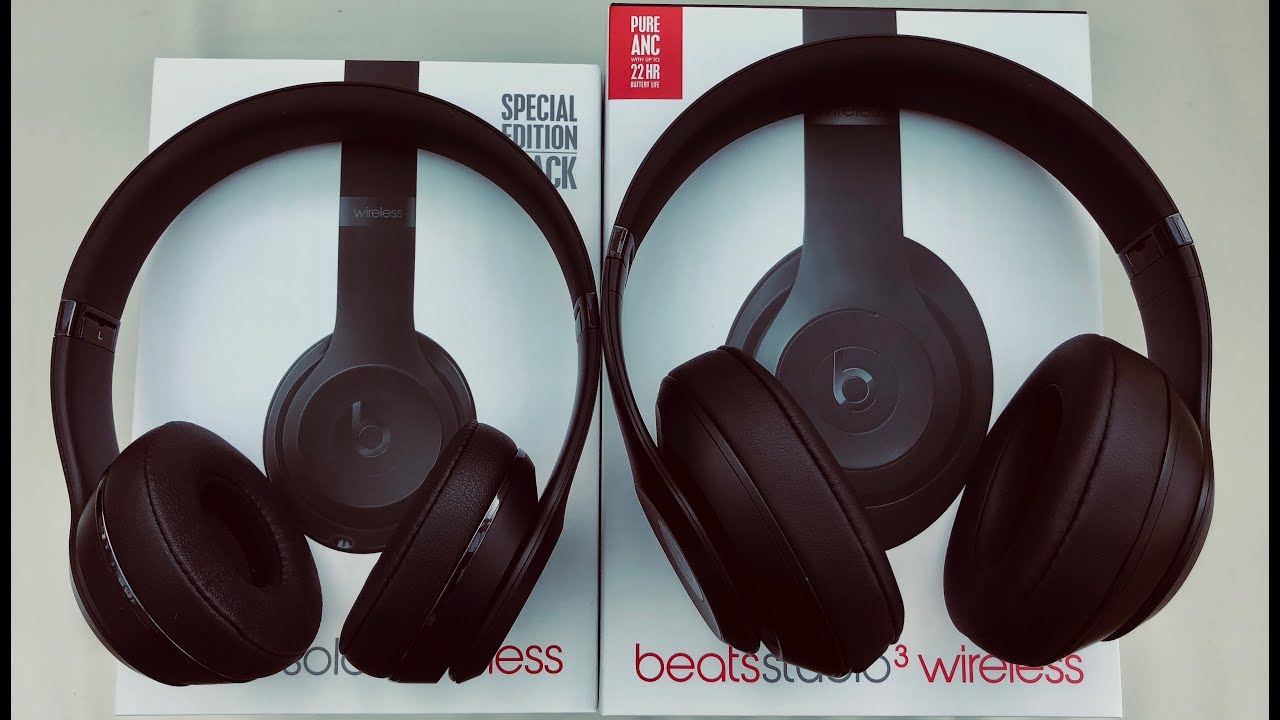Beats Solo 3 Wireless Vs Studio Wireless - Features And Functionality
When it comes to wireless headphones, the Beats brand is a popular choice among music lovers. The Beats Solo 3 Wireless vs Studio Wireless are two of the most sought-after models from the brand.
Author:James DavisMay 17, 202321.1K Shares504.5K Views

When it comes to wireless headphones, the Beats brand is a popular choice among music lovers. The Beats Solo 3 Wireless vs Studio Wirelessare two of the most sought-after models from the brand.
Both headphones offer great sound quality and wireless connectivity, but they have some key differences in design, features, and performance.
In this article, we will compare the Beats Solo 3 Wireless vs Studio Wireless headphones to help you determine which one is the better option for your needs.
Design And Build Quality
Design and Build Quality Comparison of Beats Solo 3 Wireless vs Studio Wireless
When it comes to the design and build quality of the Beats Solo 3 Wireless and Studio Wireless headphones, both are sleek and stylish over-ear headphones. However, there are a few key differences between the two models.
The Beats Solo 3 Wireless headphones have a more compact design with a foldable headband, making them easier to store and transport. They are also lighter in weight and have a more streamlined appearance. The ear cups are made of a high-quality plastic material, while the headband is made of metal with a soft cushion for added comfort.
On the other hand, the Studio Wireless headphones are larger and heavier with a more robust build. They feature an over-ear design with a durable metal frame and high-quality leather ear cushions. The ear cups are larger, making them more comfortable for extended listening sessions.
Overall, both models offer a stylish design with quality materials, but the Beats Solo 3 Wireless headphones are more compact and portable, while the Studio Wireless headphones have a more premium and durable build.
Sound Quality Comparison Of Beats Solo 3 Wireless Vs Studio Wireless
Both the Beats Solo 3 Wireless and Studio Wireless headphones are known for their powerful sound quality. However, there are some differences between the two models in terms of their sound profiles.
The Beats Solo 3 Wireless headphones have a more bass-heavy sound signature, which is great for music genres like hip-hop and electronic dance music. They also have a clear and balanced midrange and treble, which makes them suitable for a wide range of music genres.
On the other hand, the Studio Wireless headphones have a more balanced sound signature with clear and detailed mids and highs. They also have a strong bass response, but it is not as prominent as in the Solo 3 Wireless headphones.
Overall, both models offer great sound quality, but the Beats Solo 3 Wireless headphones are more suited for bass-heavy music, while the Studio Wireless headphones have a more balanced sound signature that is suitable for a wider range of music genres.

Beats Solo3 vs Studio3 Wireless: Unboxing & Review
Noise Cancellation Comparison Of Beats Solo 3 Wireless Vs Studio Wireless
Both the Beats Solo 3 Wireless and Studio Wireless headphones come with active noise cancellation technology, which is great for blocking out external sounds and immersing you in your music.
The Beats Solo 3 Wireless headphones use Pure Adaptive Noise Canceling (Pure ANC) technology to block out external sounds. Pure ANC constantly monitors the ambient sound and adjusts the noise cancellation in real-time, ensuring that you get the best possible sound quality. The headphones also have a transparency mode that lets you hear your surroundings when you need to.
The Studio Wireless headphones also come with active noise cancellation, but they use a different technology called Adaptive Noise Canceling (ANC).
This technology is designed to block out external sounds, but it doesn't adjust the noise cancellation in real-time like Pure ANC does. The headphones also have a mode called "ANC only," which turns off the audio playback and focuses only on noise cancellation.
Overall, both models offer effective noise cancellation, but the Beats Solo 3 Wireless headphones have more advanced technology that provides a more customized and immersive listening experience.
Features And Functionality
When it comes to features and functionality, the Beats Solo 3 Wireless and the Beats Studio Wireless have some similarities and differences.
The Beats Solo 3 Wireless has a W1 chip that enables easy pairing with Apple devices, as well as quick charging technology that gives you 3 hours of playback time with just 5 minutes of charging. It also has an on-ear design with adjustable ear cups, a built-in microphone for phone calls, and playback controls on the ear cups.
The Beats Studio Wireless, on the other hand, has a longer battery life of up to 20 hours, active noise-cancellation technology, and a more over-ear design that covers your entire ear for better noise isolation. It also has playback controls on the ear cups, as well as a built-in microphone for phone calls.
Both headphones have Bluetooth connectivity, but the Beats Studio Wireless also comes with a 3.5mm audio cable for wired use. Additionally, the Beats Studio Wireless has a "b" button on the left ear cup that allows you to switch between noise-cancellation modes.
In terms of features and functionality, the Beats Solo 3 Wireless is better suited for those who prioritize ease of use and portability, while the Beats Studio Wireless is better suited for those who prioritize sound quality and noise-cancellation capabilities.
Comfort And Convenience
Comfort and convenience are essential factors to consider when choosing between the Beats Solo 3 Wireless and Studio Wireless headphones.
The Beats Solo 3 Wireless headphones have an on-ear design, meaning the ear cups rest on your ears rather than surrounding them. The ear cups are cushioned with a soft material that makes them comfortable to wear for long periods. The headband is also adjustable, allowing you to find the perfect fit for your head.
The Studio Wireless headphones, on the other hand, have an over-ear design, which means the ear cups surround your ears. The ear cups are cushioned with a soft leather-like material, making them comfortable to wear for extended periods. The headband is also padded and adjustable, providing a secure and comfortable fit.
Both headphones have similar features when it comes to convenience. They both have foldable designs, making them easy to store and transport. They also come with a carrying case for added protection when not in use.
The Beats Solo 3 Wireless headphones have on-ear controls, allowing you to adjust the volume, change tracks, and take calls without having to take your phone out of your pocket. They also have a built-in microphone, which is convenient for making hands-free calls.
The Studio Wireless headphones have similar on-ear controls, allowing you to adjust the volume, change tracks, and take calls with ease. They also have a built-in microphone for making hands-free calls.
Overall, both headphones offer excellent comfort and convenience features, with the Studio Wireless headphones being slightly more comfortable due to their over-ear design. The Beats Solo 3 Wireless headphones, however, offer better on-ear controls for added convenience.
People Also Ask
Which Headphone Has Better Noise Cancellation: Beats Solo 3 Wireless Or Studio Wireless?
The Studio Wireless headphones are known for having superior noise cancellation compared to the Solo 3 Wireless. This is because they use adaptive noise cancellation technology that adjusts to the user's environment, blocking out more external noise.
However, the Solo 3 Wireless still have decent noise isolation capabilities, making them a good choice for daily use.
Are The Beats Solo 3 Wireless Or Studio Wireless Better For Traveling?
Both headphones are good for traveling, but the Solo 3 Wireless are generally considered more portable and convenient due to their smaller size and foldable design.
They also have a longer battery life of up to 40 hours, which is great for long flights. However, the Studio Wireless headphones have superior noise cancellation, making them a better choice for noisy environments like planes and trains.
Which Headphone Has Better Sound Quality: Beats Solo 3 Wireless Or Studio Wireless?
The Studio Wireless headphones are generally considered to have better sound quality compared to the Solo 3 Wireless. This is because they have larger drivers and a more refined audio signature, resulting in clearer and more detailed sound. However, the Solo 3 Wireless still have good sound quality and are a great choice for bass-heavy music genres.
Are The Beats Solo 3 Wireless Or Studio Wireless Better For Gaming?
While both headphones are capable of providing a decent gaming experience, the Studio Wireless headphones are generally considered to be better due to their superior sound quality and noise cancellation. The adaptive noise cancellation technology of the Studio Wireless also makes it easier to focus on the game without getting distracted by external noise.
Which Headphone Is More Comfortable To Wear: Beats Solo 3 Wireless Or Studio Wireless?
The comfort of the headphones largely depends on personal preference and the size and shape of the user's head and ears. However, the Studio Wireless headphones are generally considered to be more comfortable due to their over-ear design, which distributes the weight of the headphones more evenly on the head. The ear cups of the Studio Wireless are also larger and deeper, providing more space for the ears.
Final Thoughts
After a thorough comparison of the Beats Solo 3 Wireless vs Studio Wireless headphones, we can conclude that both headphones offer excellent sound quality, wireless connectivity, and comfort.
However, they differ in design, features, and performance. The Beats Solo 3 Wireless is a more portable and lightweight option with a longer battery life, while the Beats Studio Wireless offers better noise cancellation and a more premium design.
Ultimately, the choice between the two headphones will depend on your personal preferences and intended use.

James Davis
Author
James Davis keeps you updated daily with the best shopping tricks, hacks, and frugal living tips that you won’t find anywhere else. He also talks and writes about creative ways to save money, job opportunities like clever ways to make money from home, great jobs for teens, and online jobs that pay well.
James also enjoys working on Social Media campaigns for major brands. He believes in creating a personal relationship between the brand and its consumers. He is very much into taking the corporate out of the brand and bringing it down to the level where consumers can feel comfortable interacting and taking the brand seriously.
Latest Articles
Popular Articles